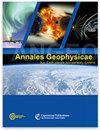On the relationship between the mesospheric sodium layer and the meteoric input function
IF 1.9
4区 地球科学
Q3 ASTRONOMY & ASTROPHYSICS
引用次数: 0
Abstract
Abstract. This study examines the relationship between the concentration of atmospheric sodium and its meteoric input function (MIF). We use the measurements from the Colorado State University (CSU) and the Andes Lidar Observatory (ALO) lidar instruments with a new numerical model that includes sodium chemistry in the mesosphere and lower-thermosphere (MLT) region. The model is based on the continuity equation to treat all sodium-bearing species and runs at a high temporal resolution. The model simulation employs data assimilation to compare the MIF inferred from the meteor radiant distribution and the MIF derived from the new sodium chemistry model. The simulation captures the seasonal variability in the sodium number density compared with lidar observations over the CSU site. However, there were discrepancies for the ALO site, which is close to the South Atlantic Anomaly (SAA) region, indicating that it is challenging for the model to capture the observed sodium over the ALO. The CSU site had significantly more lidar observations (27 930 h) than the ALO site (1872 h). The simulation revealed that the uptake of the sodium species on meteoric smoke particles was a critical factor in determining the sodium concentration in the MLT, with the sodium removal rate by uptake found to be approximately 3 times that of the NaHCO3 dimerization. Overall, the study's findings provide valuable information on the correlation between the MIF and the sodium concentration in the MLT region, contributing to a better understanding of the complex dynamics of this region. This knowledge can inform future research and guide the development of more accurate models to enhance our comprehension of the MLT region's behavior.关于中间层钠层与流星输入函数之间的关系
摘要本研究探讨了大气钠浓度与其流星输入函数(MIF)之间的关系。我们利用科罗拉多州立大学(CSU)和安第斯激光雷达观测站(ALO)激光雷达仪器的测量数据,以及一个包含中间层和低热层(MLT)区域钠化学成分的新数值模式。该模型基于连续性方程处理所有含钠物种,并以高时间分辨率运行。模型模拟采用了数据同化技术,以比较从流星辐射分布推断出的 MIF 和从新的钠化学模型推导出的 MIF。与激光雷达在 CSU 站点上空的观测结果相比,模拟捕捉到了钠数量密度的季节性变化。然而,在靠近南大西洋异常(SAA)区域的 ALO 站点存在差异,表明该模式捕捉 ALO 上观测到的钠具有挑战性。CSU 站点的激光雷达观测数据(27 930 小时)明显多于 ALO 站点(1872 小时)。模拟结果表明,流星烟雾颗粒对钠物质的吸收是决定 MLT 中钠浓度的关键因素,通过吸收去除钠的速率大约是 NaHCO3 二聚化速率的 3 倍。总之,研究结果为 MIF 与 MLT 区域钠浓度之间的相关性提供了有价值的信息,有助于更好地了解该区域的复杂动态。这些知识可以为未来的研究提供信息,并指导开发更精确的模型,从而提高我们对 MLT 区域行为的理解。
本文章由计算机程序翻译,如有差异,请以英文原文为准。
求助全文
约1分钟内获得全文
求助全文
来源期刊

Annales Geophysicae
地学-地球科学综合
CiteScore
4.30
自引率
0.00%
发文量
42
审稿时长
2 months
期刊介绍:
Annales Geophysicae (ANGEO) is a not-for-profit international multi- and inter-disciplinary scientific open-access journal in the field of solar–terrestrial and planetary sciences. ANGEO publishes original articles and short communications (letters) on research of the Sun–Earth system, including the science of space weather, solar–terrestrial plasma physics, the Earth''s ionosphere and atmosphere, the magnetosphere, and the study of planets and planetary systems, the interaction between the different spheres of a planet, and the interaction across the planetary system. Topics range from space weathering, planetary magnetic field, and planetary interior and surface dynamics to the formation and evolution of planetary systems.
 求助内容:
求助内容: 应助结果提醒方式:
应助结果提醒方式:


